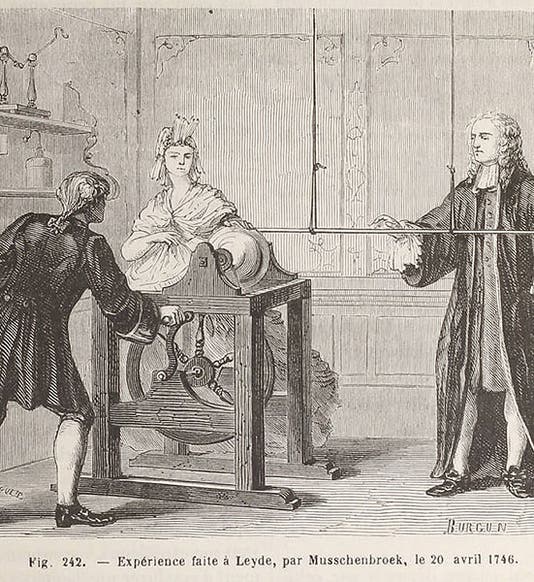Scientist of the Day - Ewald Jürgen von Kleist
Ewald Jürgen von Kleist, a Pomeranian cleric, judge, and dabbler in electrical science, was born June 10, 1700. For 23 years, von Kleist had been Dean of the Cathedral in Kamien Pomorski, Pomerania, in northwest Poland, when on Oct. 11, 1745, in a most unclerical move, von Kleist invented the electrical capacitor. A modern capacitor consists of two metal plates separated by a thin insulator; the positive charge that accumulates on one plate attracts a negative charge on the other plate, and the insulator keeps the charges together but separated. A capacitor has quite a capacity for charge, and if one connects the two plates with a conductor, the charges equalize, often violently. In von Kleist's day, no one knew what electricity was, or how a capacitor might work, so what von Kleist was trying to do was simply store electricity, and he chose a medicine bottle with water in it to hold the electricity, and a nail sticking out of it to touch to a static electricity machine. After “filling” his bottle, if he now touched the nail, he got a nasty shock, indicating there really was electricity in the bottle.
Von Kleist wrote to other German experimenters about his invention, but he neglected to mention – because he wasn't aware of its importance – that you have to hold the bottle in your hand when you charge it, or it won't collect electricity. So none of those who tried could duplicate his discovery. Then, quite independently, in January of 1746, an experimenter in Leiden, Petrus van Musschenbroek, followed the same path of discovery; he filled a jar with water, inserted a central metal rod, and holding the jar in his hand, touched the end of the rod to an electrostatic generator. After he “filled” his jar with electricity, while still holding the jar, he touched the central metal rod with his finger, and the shock nearly tore his arm off. He immediately wrote a letter to Paris detailing the experiment (mentioning that he would not repeat it “for all the Kingdom of France”), and soon experimenters throughout Europe were incapacitating themselves and their wives, children, and servants, with the potent "Leyden jar," as it came to be called. Had von Kleist done a better job of describing his apparatus, it might have been called a "Pomeranian bottle.”
To the best of my knowledge, there are no images that record von Kleist’s electrical adventures, although there are several illustrations that show Musschenbroek’s experiments. We show one (first image) that we have in a 19th-century work – Musschenbroek is at the right, with the Leyden bottle in his left hand, about to touch the prime conductor with his finger. It is a pleasant scene, but one wishes the illustrator had captured what ensued a second later. We do have two letters in our Library written by von Kleist describing his electrical bottle; he wrote them to Johann Gottlob Krüger, and Krüger included them as an appendix to a 1746 volume on geology, Geschichte der Erde, that we have in our collections. We thank a diligent cataloguer for noticing and recording the von Kleist letters, or who would ever have known? You may check our catalog entry for Krüger’s book, if you are interested; see the general notes at the end.
Von Kleist’s and Musschenbroek’s invention became an essential piece of equipment in every electrical laboratory until the battery was invented at the very end of the 18th-century. It was soon discovered that liquid in the bottle was not essential; one could coat the inner and outer surfaces of the bottle with metal foil, and it worked even better. Leyden jars were often connected together in series to provide even more heart-stopping power; here is a quartet of them in the Boerhaave Museum in Leiden, and a bank of 25 at Teylers Museum in Haarlem is shown above (second image).
The Cathedral of John the Baptist in Kamien Pomorski is a National Landmark in Poland, but I am fairly confident that the official citation does not mention the fact that the Leyden jar was invented there by Ewald von Kleist. The first time I checked the Wikipedia entry on Kamien Pomorski (this was in 2014), von Kleist was listed as one of the town’s five notable residents, but he no longer appears on the list, having been bumped by a retired long-distance runner who was born in 1955. Von Kleist does have a memorial graveyard stone in the local cemetery, which is clearly of modern vintage, and which mentions the Polish word for electricity, so he hasn’t been completely forgotten in his hometown.
Early electrical experimenters of the 1740s-50s have turned up frequently in this series; if the subject interests you, you might check the posts on William Watson, Jean-Antoine Nollet, Giovanni Battista Beccaria, and, of course, Benjamin Franklin.
Dr. William B. Ashworth, Jr., Consultant for the History of Science, Linda Hall Library and Associate Professor emeritus, Department of History, University of Missouri-Kansas City. Comments or corrections are welcome; please direct to ashworthw@umkc.edu.







